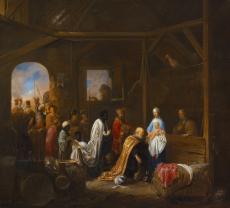


The 'Adoration of the Magi' takes place in a welldefined barn interior with the three kings, or wise men, in front of Mary, who has the Christ child on her lap. Behind her on the right, beside a wooden partition stands Joseph, while the extensive entourage of the magi form a line that extends outside of the stable. Through an open window, heads of curious onlookers are visible, gazing upon the goings-on inside. Through this opening and the open door we see an azure sky with grey clouds. The sunlight streaming into the interior is responsible for the nice chiaroscuro effects. Furthermore, thanks to the rich garments of the three kings and Mary in her light blue attire, the painting has a pleasant palette. The quality of the work is further enhanced by the carefully rendered details, such as the manger in the bottom right, which has all the signs of being an improvised baby bed.
The panel is not signed. A search for the artist possibly responsible for such colouring and chiaroscuro compels one to look initially among the early followers of Rembrandt. Undoubtedly, these elements were responsible for the painting being offered for sale in the 20th century under the name of Gerard Dou (1613- 1675), Rembrandt’s first pupil. However, this attribution is certainly mistaken. Already when the Adoration of the Magi was auctioned in 1926 in Amsterdam, the eminent connoisseur of 17th-century Dutch painting, Cornelis Hofstede de Groot, noted that he could not recognize any trace of Dou’s hand in it. It reminded him more of the work of Willem de Poorter (1608-1649/51), although he was quite sure this was not the artist responsible for the work either. The problem of attribution was solved only around 1960, when Sturla Gudlaugsson, then director of the Rijksbureau voor Kunsthistorische Documentatie [Netherlands Institute for Art History], noted that the painting was by Pieter Symonsz. Potter.2 On the basis of the pleasing palette and the refined manner in which the heads of the main figures were painted, this work can be dated to the 1640s, before Pieter fell under the influence of the work of his more successful son, Paulus Potter (1625-1654).
Pieter Potter was the son of a glass painter, Simon Jacobsz., and was presumably trained by his father in their native town of Enkhuizen. In 1628 Pieter settled in Leiden, where he entered the glassmaker’s guild, becoming its headman in 1629. In these years his interest shifted from glass painting to easel painting. Under the influence of his fellow Leiden townsman Rembrandt, he created his first history paintings and also monochromatic rustic still lifes, which are stylistically close to the work of Jan Davidsz. de Heem (see p. 80), who lived in Leiden at that time. In 1631 Pieter acted as a witness for the baptism of de Heem’s son Cornelis. Later that year Potter moved to Amsterdam, where he remained until his death. Between 1647 and 1649 he was a member of the painters’ guilds in The Hague and nearby Delft, but he probably never left Amsterdam. Besides still lifes and history scenes, Pieter Potter also painted guardroom interiors, military skirmishes, portraits and landscapes. Since he signed his pictures P. Potter, they were often attributed to his famous son, Paulus, whom he had trained himself.
It is noteworthy that until the auction of 1926 in Amsterdam, Potter’s 'Adoration of the Magi; was always accompanied by a pendant with an 'Adoration of the Shepherds'. This was painted on a panel of equal size and is also illustrated in the catalogue. At the sale, both works were ‘bought in’ (unsold) and apparently went back to their owner, the Comtesse de Montmort. Thus, their unfortunate separation must have occurred somewhat later. In any event, the Adoration of the Magi was sold in 1964 without its companion piece.
He was the son of a glass painter and settled in Leiden and later in Amsterdam. His early history paintings and still lifes bear similarities to the work of Jan Davidsz. de Heem, whom he knew. He also painted guardroom interiors, battle scenes, portraits and landscapes. He was the father of the more famous artist Paulus Potter.